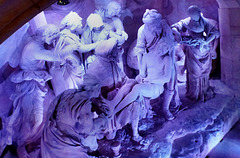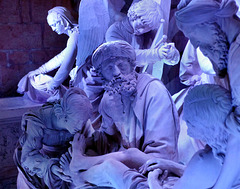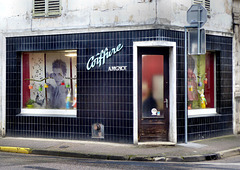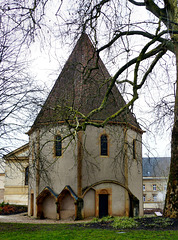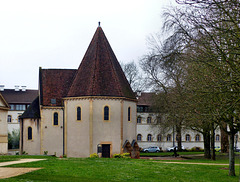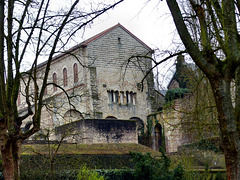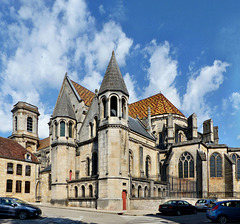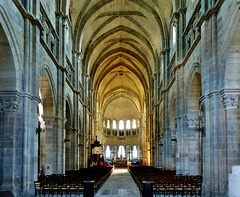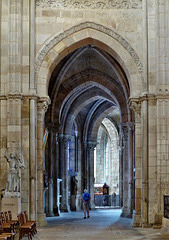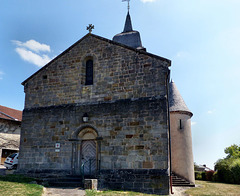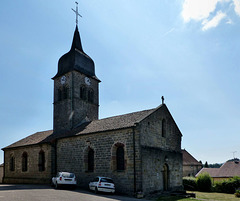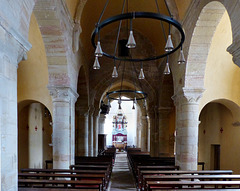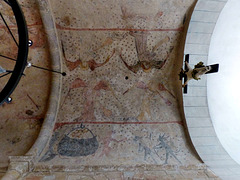
Grand Est
A collection of photos taken over the years. in the region "Grand Est", existing since 2016 and formed by Ardennes (08), Aube (10),
Marne (51), Haute-Marne (52), Meurthe-et-Moselle (54), Meuse (55), Moselle (57), Bas-Rhin (67), Haut-Rhin (68) and Vosges (88).
Saint-Mihiel - Saint-Étienne
| |
|
Saint-Mihiel developed around a convent founded by Count Wulfoalde and his wife Adalsinde around 708.
This settlement had a parish church already in the 10th century. The Romanesque structure got renovated and rebuilt in the 13th and enlarged in the 16th century. During the French Revolution, the church was used as a hospital, but got re-consecrated in 1802. Soon plans were made, to broaden the road passing the church. So in 1823 the old belltower, one aisle and the side chapel were demolished and the facade was rebuilt.
Renaissance sculptor Ligier Richier was born in Saint-Mihiel around 1500. One of his major works is inside Saint-Étienne.
Saint-Mihiel - Saint-Étienne
| |
|
Saint-Mihiel had a parish church already in the 10th century. The Romanesque structure got renovated and rebuilt in the 13th and enlarged in the 16th century. During the French Revolution, the church was used as a hospital, but got re-consecrated in 1802. Soon plans were made, to broaden the road passing the church, so in 1823 the old belltower, one aisle and the side chapel were demolished.
Renaissance sculptor Ligier Richier, a genius of his time, was born in Saint-Mihiel around 1500.
One of his major works, the "Mise au Tombeau" (Christ being placed in the tomb) is here, seen behind the metal grid.
Ligier Richier, who had unsuccessfully petitioned the Duke of Lorraine to allow him to practice in the reformed Protestant religion, completed this "entombment", before he left Lorraine and moved to Geneva, where he was free to follow this religion.
Saint-Mihiel - Saint-Étienne
| |
|
Saint-Mihiel had a parish church already in the 10th century. The Romanesque structure got renovated and rebuilt in the 13th and enlarged in the 16th century. During the French Revolution, the church was used as a hospital, but got re-consecrated in 1802. Soon plans were made, to broaden the road passing the church, so in 1823 the old belltower, one aisle and the side chapel were demolished.
Renaissance sculptor Ligier Richier, a genius of his time, was born in Saint-Mihiel around 1500.
One of his major works is the "Mise au Tombeau".
The iron grid, that saves it from nosy tourists, - and the blue light make it difficult to take a decent photo. It is a fantastic sculpture.
Ligier Richier, who had unsuccessfully petitioned the Duke of Lorraine to allow him to practice in the reformed Protestant religion, completed this "entombment", before he left Lorraine and moved to Geneva, where he was free to follow this religion.
Saint-Mihiel - Saint-Étienne
| |
|
|
|
Saint-Mihiel had a parish church already in the 10th century. The Romanesque structure got renovated and rebuilt in the 13th and enlarged in the 16th century. During the French Revolution, the church was used as a hospital, but got re-consecrated in 1802. Soon plans were made, to broaden the road passing the church, so in 1823 the old belltower, one aisle and the side chapel were demolished.
Renaissance sculptor Ligier Richier, a genius of his time, was born in Saint-Mihiel around 1500.
One of his major works is the "Mise au Tombeau".
The grid, that saves it frim nosy tourists, - and the blue light make it difficult to take a decent photo. It is a fantastic sculpture.
Ligier Richier, who had unsuccessfully petitioned the Duke of Lorraine to allow him to practice in the reformed Protestant religion, completed this "entombment", before he left Lorraine and moved to Geneva, where he was free to follow this religion.
Saint-Mihiel - Salon de Coiffure
| |
|
|
The colours of spring, seen in the shop windows of a "Salon de Coiffure" in Saint-Mihiel.
Metz - Chapelle des Templiers
| |
|
The Knights Templar (aka "Poor Fellow-Soldiers of Christ and of the Temple of Solomon") settled in Metz mid 12th century. The first donation is recorded 1147, after Bernard de Clairvaux had preached the 2nd Cruisade in Metz.
The (octagonal) rotunda is the only remaining structure of the "commanderie", that once existed here. It was built 1180 - 1220 and like many similar churches the Knights Templar erected all over Europe, this is a "copy" of the Church of the Holy Sepulchre in Jerusalem.
It is the only rotunde in Lorraine, and has parallels to the chapel the Knights Templar built in Laon around 1140.
Metz - Chapelle des Templiers
| |
|
The Knights Templar (aka "Poor Fellow-Soldiers of Christ and of the Temple of Solomon") settled in Metz mid 12th century. The first donation is recorded 1147, after Bernard de Clairvaux had preached the 2nd Cruisade in Metz.
The (octagonal) rotunda is the only remaining structure of the "commanderie", that once existed here. It was built 1180 - 1220 and like many similar churches the Knights Templar erected all over Europe, this is a "copy" of the Church of the Holy Sepulchre in Jerusalem.
It is the only rotunde in Lorraine, and has parallels to the chapel the Knights Templar built in Laon around 1140.
Metz - Saint-Pierre-aux-Nonnains
| |
|
Saint-Pierre-aux-Nonnains is the oldest existing church in France - and one of the oldest in Europe. When the first building got erected ~ 380, it was part of Roman thermal complex. The structure then was converted into a church in the 7th century when it became the chapel of a Benedictine nunnery. The nave got reconstructed and an apse added in the 10/11th century.
The church got severely damaged in 1552, when Charles V´s toops besieged Metz. The convent got dissolved and from then on the church was used as a warehouse. It got finally restored in the 1970s and now is open for concerts and exhibitions, - when it is not locked.
Metz - Saint-Pierre-aux-Nonnains
| |
|
Saint-Pierre-aux-Nonnains is the oldest existing church in France - and one of the oldest in Europe. When the first building got erected ~ 380, it was part of Roman thermal complex. The structure then was converted into a church in the 7th century when it became the chapel of a Benedictine nunnery. The nave got reconstructed and an apse added in the 10/11th century.
The church got severely damaged in 1552, when Charles V´s toops besieged Metz. The convent got dissolved and from then on the church was used as a warehouse. It got finally restored in the 1970s and now is open for concerts and exhibitions, - when it is not locked.
Langres - Cathédrale Saint-Mammès
| |
|
Langres is built on a promontory originally occupied by the Gauls and later by the Romans, who fortified the town and named it Andemantunum.
Langres was the center of a diocese already in the 4th century. Saint Didier de Langres was the 3rd bishop here. He got martyred, when the Vandals took the town in 407.
In medieval times the bishops were very powerful and so around 1140 it was decided to replace the old and small cathedral with a new one. At that time the cathedral in Sens was already under construction in Gothic style.
The erection began with the choir, seen here, probably influenced by Cluny III. The cathedral was completed and dedicated in 1196, only the vaults were added later.
After a fire 1562, caused by lightning, the cathedral was not properly rebuilt and when in 1746 the the west side threatened to collapse, itb was decided to demolish it. It then was rebuilt from 1761 to 1786 in the classical style (see the tower).
Langres - Cathédrale Saint-Mammès
| |
|
|
|
Langres is built on a promontory originally occupied by the Gauls and
later by the Romans, who fortified the town and named it Andemantunum.
Langres was the center of a diocese already in the 4th century. Saint Didier de Langres was the 3rd bishop here. He got martyred, when the Vandals took the town in 407.
In medieval times the bishops were very powerful and so around 1140 it was decided to replace the old and small cathedral with a new one. At that time the cathedrals in Sens (200kms east) and Saint Denis (300kms northwest) were already under construction.
The erection began in the east with the choir, that was probably influenced by Cluny III. The cathedral was completed and dedicated in 1196. The nave, probably following the example of the cathedral in Sens, was done in an early Gothic style. The total (interior) length of the cathedral is more than 90 meters.
Langres - Cathédrale Saint-Mammès
| |
|
|
Langres is built on a promontory originally occupied by the Gauls and later by the Romans, who fortified the town and named it Andemantunum.
Langres was the center of a diocese already in the 4th century. Saint Didier de Langres was the 3rd bishop here. He got martyred, when the Vandals took the town in 407.
In medieval times the bishops were very powerful and so around 1140 it was decided to replace the old and small cathedral with a new one. At that time the cathedrals in Sens (200kms east) and Saint Denis (300kms northwest) were already under construction.
The erection began in the east with the choir, that was probably influenced by Cluny III. The cathedral was completed and dedicated in 1196. The nave, probably following the example of the cathedral in Sens, was done in an early Gothic style. The total (interior) length of the cathedral is more than 90 meters.
The cathedral has a large ambulatory. The entrance is guarded by a statue of Jeanne d'Arc.
Langres - Cathédrale Saint-Mammès
| |
|
|
Langres is built on a promontory originally occupied by the Gauls and later by the Romans, who fortified the town and named it Andemantunum.
Langres was the center of a diocese already in the 4th century. Saint Didier de Langres was the 3rd bishop here. He got martyred, when the Vandals took the town in 407.
In medieval times the bishops were very powerful and so around 1140 it was decided to replace the old and small cathedral with a new one. At that time the cathedrals in Sens (200kms east) and Saint Denis (300kms northwest) were already under construction.
The erection of the cathedral began with the choir, that was probably influenced by Cluny III. It was completed in 1196. The nave, following the example of the cathedral in Sens, was done in an early Gothic style.
The "Christ au Tombeau" originally belonged to a a sculpted group of eight figures. It is ascribed to Dutch Claus de Werve (1380 - 1439), nephew and apprentance of master-sculptor Claus Sluter, the most important northern European sculptor of his time.
The frescoe behind depicts the Crucification of Saint Andrew. It is dated to the 14th century. It was found in 1943 after an explosion had destroyed the wooden panels and the plaster that had hidden the frescoe.
Langres - Diderot
| |
|
|
In the backdrop are the two towers of the Cathédrale Saint-Mammès.
To the very left the statue of Denis Diderot, the most notable person, that ever came from Langres. Diderot was a philosopher, scientist, writer and co-founder, chief editor, and contributor to the Encyclopédie along with Jean d'Alembert. Denis Diderot was a prominent figure during the Enlightenment.
It seems like his family by now runs the boulangerie to the right.
Isches - Saint-Brice
| |
|
The church, today located in the center of the village, was erected mid 12th century, when it was part of a castle. A century later the church got enlarged andf later further modified.
Isches - Saint-Brice
| |
|
|
The church, today located in the center of the village, was erected mid 12th century, when it was part of a castle. A century later the church got enlarged andf later further modified.
Isches - Saint-Brice
| |
|
|
|
The church, today located in the center of the village, was erected mid 12th century, when it was part of a castle. A century later the church got enlarged andf later further modified.
Isches - Saint-Brice
| |
|
|
The church, today located in the center of the village, was erected mid 12th century, when it was part of a castle. A century later the church got enlarged and later further modified.
In 2009, during the restauration of the church, faded frescoes from the 14th/15the century were decovered under the plaster. Probably a "Last Judgement".
Jump to top
RSS feed- Latest items - Subscribe to the latest items added to this album
- ipernity © 2007-2024
- Help & Contact
|
Club news
|
About ipernity
|
History |
ipernity Club & Prices |
Guide of good conduct
Donate | Group guidelines | Privacy policy | Terms of use | Statutes | In memoria -
Facebook
Twitter



